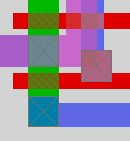

|
Magic Mailing List |
|
From: Dr. Jon R. Fox (jfox AT princeton DOT edu) Date: Tue Jul 24 2001 - 14:42:39 EDT
Thanks Tim, but I can't take credit for the idea. It's a cheap way of making masks on a shoestring that's been floating around on the 'net and the MEMS-ISI list for a time now.
Thanks for the info. My output looks to scale now, instead of scaled to the page.
If I get good with docbook maybe I can help write that into the man page and the ps tutorials. Anything to help out in repayment! I've also been working on a CIF to PS converter written in python, to go with the CIF drawing objects I wrote last week.
Jon
(happy user)
On Tue, Jul 24, 2001 at 01:15:57PM -0400, R. Timothy Edwards wrote:
> Dear Jon,
>
> I hadn't really intended for the PostScript output to be used for making
> photomasks, but that's a cool idea!
>
> The magic PostScript driver auto-scales the output to fit a printed page,
> so what you're probably getting is output that fits exactly to an 8.5" by
> 11" page with 1" margins. If you want some exact scaling between magic
> units and actual size, you'll have to do a little calculation. But you
> can get what you want by changing the parameters, which show up by typing
>
> :plot parameters
>
> in magic. What you want is to set PS_width, PS_height, and PS_margin
> appropriately. Because the PostScript output is whatever is in the select
> box, the output scale is relative to the select box on the screen when you
> do the ":plot postscript <file>" command. In other words, the driver scales
> the output such that the select box and its contents fit exactly within
> (PS_width - 2 * PS_margin) or (PS_height - 2 * PS_margin), whichever is
> smaller.
>
> I assume that you've already figured out that for mask use, you will
> want to rewrite the "plot style postscript" section of the techfile so
> that all layers have a completely solid (style #5 in the scmos.tech27
> file supplied with the magic distribution) and black (color #14 in
> scmos.tech27) color style, and you will write out each layer separately
> using the ":plot postscript <file> [layers]" syntax. However (and this
> also applies to pplot, and possibly cif2ps as well), because the programs
> were designed for viewing and not for mask creation, you may find that
> box borders are causing the printed geometry to be bigger than you expect.
> If so, you should remove all lines ending in "ml", "vl", and "hl" from the
> output, which are all the boundary lines, keeping only the "fb" filled boxes.
>
> If you continue to have problems with the PostScript output, please let
> me know.
> Regards,
> Tim
--
Dr. Jon R. Fox
fox AT researchsupport DOT com
Principal Scientist - Research Support Instruments
tel: (609)258-1022 | cel: (609)903-3567 | efax:(208)247-2567
|
|
|

|